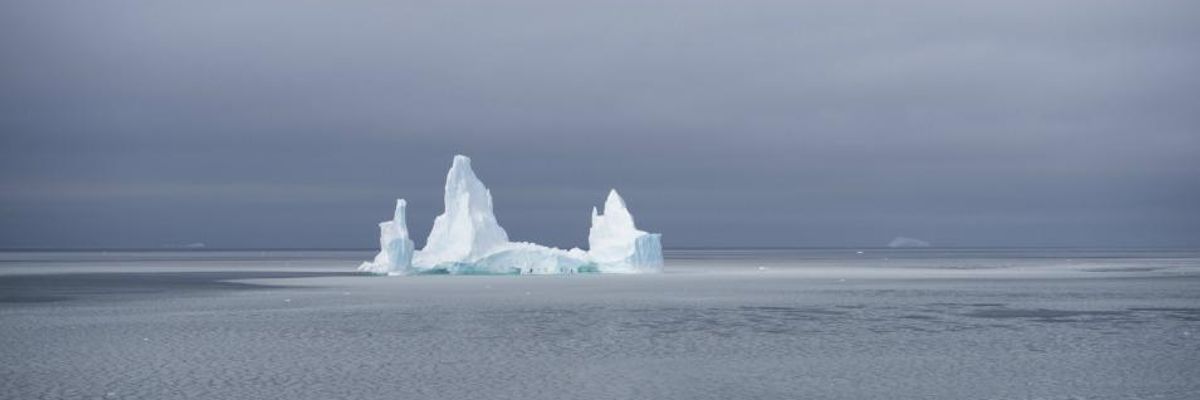

SUBSCRIBE TO OUR FREE NEWSLETTER
Daily news & progressive opinion—funded by the people, not the corporations—delivered straight to your inbox.
5
#000000
#FFFFFF
To donate by check, phone, or other method, see our More Ways to Give page.


Daily news & progressive opinion—funded by the people, not the corporations—delivered straight to your inbox.

A glacier in the Amundsen Sea in West Antarctica. (Photo: Povl Abrahamsen/flickr/cc)
The rate of melting ice in Antarctica's vulnerable Amundsen Sea region has tripled in the past decade, a new report published in Geophysical Research Letters on Wednesday has found.
Analyzing 21 years of data from four separate observation techniques, scientists from NASA and UC Irvine (UCI) discovered that glaciers in the region are shedding more ice mass than any other part of Antarctica and are the biggest contributors to rising sea levels in the region.
"The mass loss of these glaciers is increasing at an amazing rate," said Isabella Velicogna of UCI and NASA's Jet Propulsion Laboratory, who co-authored the report. She added that the changes "are proceeding very fast."
The study examined more than two decades' worth of data on "mass balance" of glaciers in the Amundsen Sea Embayment--including "how much ice the glaciers gain and lose over time from accumulating or melting snow, discharges of ice as icebergs, and other causes"--between 1992 and 2013.
The glaciers in the region lost mass throughout that entire period, at an ever-increasing speed. In fact, they are shedding roughly 91.5 billion tons of ice every year at a rate which grew by an average of 6.7 billion tons annually since 1992.
That rate is "almost three times the rate of increase for the full 21-year period," the authors wrote. "By comparison, Mt. Everest weighs about 161 gigatons (177 billion U.S. tons), meaning the Antarctic glaciers lost an amount of water weight equivalent to Mt. Everest every two years over the last 21 years."
The study's lead author Tyler Sutterley, a doctoral candidate at UCI, noted that "Previous studies had suggested that this region is starting to change very dramatically since the 1990s, and we wanted to see how all the different techniques compared. The remarkable agreement among the techniques gave us confidence that we are getting this right."
In May, a separate joint NASA-UC Irvine report discovered that the eventual glacier loss "appears unstoppable," according to that team's lead researcher, Eric Rignot. Because the majority of West Antarctica's ice sheet is attached to a sub-sea level ice bed, warmer ocean currents are able to eat away at the "grounding line"--the area where the ice meets the bed.
According to that study:
When ice shelves lose mass, they lose the ability to hold back inland glaciers from their march to the sea, meaning those glaciers can accelerate and thin as a result of the acceleration. This thinning is only conducive to more grounding line retreat, more acceleration and more thinning. In this equation, more ice flows to sea every year and sea level rises.
The Amundsen Sea is also vulnerable to a much warmer regional ocean current than other parts of West Antarctica, the earlier study found.
According to Velicogna, glacier and ice sheet behavior around the globe is the greatest uncertainty in predicting future sea levels. In October, the Australian National University found that they are rising at an unprecedented rate, while the Lawrence Livermore National Laboratory discovered that same month that the rate of ocean warming has been vastly underestimated.
Dear Common Dreams reader, The U.S. is on a fast track to authoritarianism like nothing I've ever seen. Meanwhile, corporate news outlets are utterly capitulating to Trump, twisting their coverage to avoid drawing his ire while lining up to stuff cash in his pockets. That's why I believe that Common Dreams is doing the best and most consequential reporting that we've ever done. Our small but mighty team is a progressive reporting powerhouse, covering the news every day that the corporate media never will. Our mission has always been simple: To inform. To inspire. And to ignite change for the common good. Now here's the key piece that I want all our readers to understand: None of this would be possible without your financial support. That's not just some fundraising cliche. It's the absolute and literal truth. We don't accept corporate advertising and never will. We don't have a paywall because we don't think people should be blocked from critical news based on their ability to pay. Everything we do is funded by the donations of readers like you. Will you donate now to help power the nonprofit, independent reporting of Common Dreams? Thank you for being a vital member of our community. Together, we can keep independent journalism alive when it’s needed most. - Craig Brown, Co-founder |
The rate of melting ice in Antarctica's vulnerable Amundsen Sea region has tripled in the past decade, a new report published in Geophysical Research Letters on Wednesday has found.
Analyzing 21 years of data from four separate observation techniques, scientists from NASA and UC Irvine (UCI) discovered that glaciers in the region are shedding more ice mass than any other part of Antarctica and are the biggest contributors to rising sea levels in the region.
"The mass loss of these glaciers is increasing at an amazing rate," said Isabella Velicogna of UCI and NASA's Jet Propulsion Laboratory, who co-authored the report. She added that the changes "are proceeding very fast."
The study examined more than two decades' worth of data on "mass balance" of glaciers in the Amundsen Sea Embayment--including "how much ice the glaciers gain and lose over time from accumulating or melting snow, discharges of ice as icebergs, and other causes"--between 1992 and 2013.
The glaciers in the region lost mass throughout that entire period, at an ever-increasing speed. In fact, they are shedding roughly 91.5 billion tons of ice every year at a rate which grew by an average of 6.7 billion tons annually since 1992.
That rate is "almost three times the rate of increase for the full 21-year period," the authors wrote. "By comparison, Mt. Everest weighs about 161 gigatons (177 billion U.S. tons), meaning the Antarctic glaciers lost an amount of water weight equivalent to Mt. Everest every two years over the last 21 years."
The study's lead author Tyler Sutterley, a doctoral candidate at UCI, noted that "Previous studies had suggested that this region is starting to change very dramatically since the 1990s, and we wanted to see how all the different techniques compared. The remarkable agreement among the techniques gave us confidence that we are getting this right."
In May, a separate joint NASA-UC Irvine report discovered that the eventual glacier loss "appears unstoppable," according to that team's lead researcher, Eric Rignot. Because the majority of West Antarctica's ice sheet is attached to a sub-sea level ice bed, warmer ocean currents are able to eat away at the "grounding line"--the area where the ice meets the bed.
According to that study:
When ice shelves lose mass, they lose the ability to hold back inland glaciers from their march to the sea, meaning those glaciers can accelerate and thin as a result of the acceleration. This thinning is only conducive to more grounding line retreat, more acceleration and more thinning. In this equation, more ice flows to sea every year and sea level rises.
The Amundsen Sea is also vulnerable to a much warmer regional ocean current than other parts of West Antarctica, the earlier study found.
According to Velicogna, glacier and ice sheet behavior around the globe is the greatest uncertainty in predicting future sea levels. In October, the Australian National University found that they are rising at an unprecedented rate, while the Lawrence Livermore National Laboratory discovered that same month that the rate of ocean warming has been vastly underestimated.
The rate of melting ice in Antarctica's vulnerable Amundsen Sea region has tripled in the past decade, a new report published in Geophysical Research Letters on Wednesday has found.
Analyzing 21 years of data from four separate observation techniques, scientists from NASA and UC Irvine (UCI) discovered that glaciers in the region are shedding more ice mass than any other part of Antarctica and are the biggest contributors to rising sea levels in the region.
"The mass loss of these glaciers is increasing at an amazing rate," said Isabella Velicogna of UCI and NASA's Jet Propulsion Laboratory, who co-authored the report. She added that the changes "are proceeding very fast."
The study examined more than two decades' worth of data on "mass balance" of glaciers in the Amundsen Sea Embayment--including "how much ice the glaciers gain and lose over time from accumulating or melting snow, discharges of ice as icebergs, and other causes"--between 1992 and 2013.
The glaciers in the region lost mass throughout that entire period, at an ever-increasing speed. In fact, they are shedding roughly 91.5 billion tons of ice every year at a rate which grew by an average of 6.7 billion tons annually since 1992.
That rate is "almost three times the rate of increase for the full 21-year period," the authors wrote. "By comparison, Mt. Everest weighs about 161 gigatons (177 billion U.S. tons), meaning the Antarctic glaciers lost an amount of water weight equivalent to Mt. Everest every two years over the last 21 years."
The study's lead author Tyler Sutterley, a doctoral candidate at UCI, noted that "Previous studies had suggested that this region is starting to change very dramatically since the 1990s, and we wanted to see how all the different techniques compared. The remarkable agreement among the techniques gave us confidence that we are getting this right."
In May, a separate joint NASA-UC Irvine report discovered that the eventual glacier loss "appears unstoppable," according to that team's lead researcher, Eric Rignot. Because the majority of West Antarctica's ice sheet is attached to a sub-sea level ice bed, warmer ocean currents are able to eat away at the "grounding line"--the area where the ice meets the bed.
According to that study:
When ice shelves lose mass, they lose the ability to hold back inland glaciers from their march to the sea, meaning those glaciers can accelerate and thin as a result of the acceleration. This thinning is only conducive to more grounding line retreat, more acceleration and more thinning. In this equation, more ice flows to sea every year and sea level rises.
The Amundsen Sea is also vulnerable to a much warmer regional ocean current than other parts of West Antarctica, the earlier study found.
According to Velicogna, glacier and ice sheet behavior around the globe is the greatest uncertainty in predicting future sea levels. In October, the Australian National University found that they are rising at an unprecedented rate, while the Lawrence Livermore National Laboratory discovered that same month that the rate of ocean warming has been vastly underestimated.